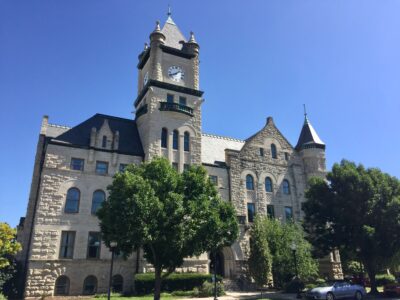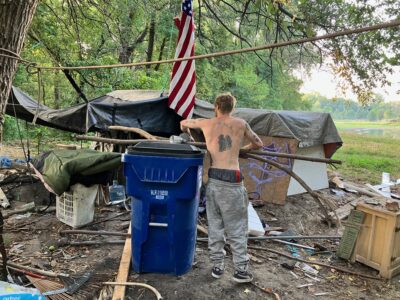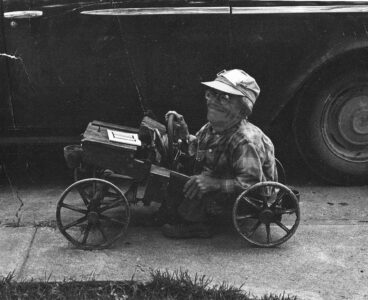Humane society, pig rescue offer highway ‘jumper’ a web of support

After tumbling off a truck on the highway, a young pig was rescued and is now on the road to recovery thanks to a dedicated network of rescuers and caregivers.
Gilbert — the pig who was rescued by someone driving close behind the truck and witnessed the fall — is known as a “jumper,” or a pig that leaps or falls from transport trucks, typically while being moved from a breeding facility to a slaughterhouse. Following the incident, the bystander immediately brought him to the Lawrence Humane Society where he received immediate attention.
Gilbert landed snout-first when he fell, which dislocated his jaw. Later, an X-ray revealed that the fall had also injured his C1 vertebra. The injury caused inflammation and muscle spasms, making it difficult for him to eat.
“While Gilbert had been eating, it was taking him a really long time to eat, and that’s why,” Elina Alterman, director of development and communications at the Lawrence Humane Society told the Journal-World.
Trucks like the one Gilbert came from often have vent holes on their sides, and Angela Willey, a team member at the Kansas City Pig Rescue Network, said these holes can be big enough for piglets to fit through, and results in them tumbling down the highway.
“The truck either changes lanes or has to come to a quick stop, or the piglets get scared and climb on top of each other, and one of them shoots out of that hole,” Willey said. “It drops out of the truck, hits the interstate and rolls into the median.”

photo by: Lawrence Humane Society
Gilbert the Pig after falling or jumping off of a transport truck on a highway.
From the Lawrence Humane Society, Gilbert was transferred to the care of the Kansas City Pig Rescue Network, or KCPRN, which works to rescue, rehabilitate and find homes for the pigs that come into their care. When he arrived there, Gilbert received a muscle relaxer injection to help with his injuries.
“After he’d gotten that muscle relaxer injection, he chowed down and all the struggles that he was having with eating had all basically gone away because that muscle was relaxed,” Alterman said.
Willey said the rescue typically handles four to six jumpers per season – spring and fall – but it mainly happens in the spring.
“I always tell people who want to understand what their injuries are to imagine falling off of that truck at 85 miles an hour,” Willey said.
Willey said the KCPRN also has a permanent pig resident that was a jumper. The pig’s name is Thad, and he’s been at the rescue for six years. He was found in the Kansas City area on Interstate 35, and she said he was one of the lucky ones.
“He had road rash from his nose to his groin, so he just slid down the interstate at 85 miles an hour,” Willey said. “We’ve had jumpers come in with broken legs, broken pelvises, skull fractures, brain bleeds, internal organ damage. It just kind of depends on where they land and how they land.”
Willey added that usually any time a jumper pig comes into their rescue, their team anticipates something to be broken, especially since the pigs that do jump off the trucks could weigh as small as four pounds.
“When it comes to us, we rejoice when there’s nothing injured,” Willey said.
Willey said it’s important to get the pigs to someone who knows how to handle them, and a good first step is making sure they get to the humane society, where they can hopefully be referred to pig professionals.
After Gilbert was brought to the Lawrence Humane Society, he spent his stray hold with Alterman, who has two pigs of her own – Petunia and Periwinkle, and decided to foster him before he went to the KCPRN.
Petunia was also a jumper, the first one that ever came to the Lawrence Humane Society, and she was later adopted from the KCPRN.
“It was nice to have a piglet, because obviously, mine are now 700 pounds,” Alterman said. “When I got them, they were about five pounds each, so it was nice to have a piglet again and snuggle him … and in the same way that if you’ve raised a dog from a puppy. It’s nice to have a puppy in the home again.”
While Gilbert continues to receive the medical care he needs, the KCPRN has already secured a home for him. Alterman said the new owners have previously adopted two other large pigs from KCPRN, and one of them has knowledge in veterinary care.

photo by: Lawrence Humane Society
Gilbert the Pig
“One of the other reasons we partner with KCPRN is because they know what to look for in a home for a pig in a way that we don’t,” Alterman said. “They know which communities and zoning laws allow for pigs because not all cities, towns and neighborhoods would allow someone to have a pig.”
However, Alterman said it can be very difficult to find pig care, and said that’s why the partnership with KCPRN has been so important. Since its inception in 2017, the KCPRN has had approximately 500 pigs come through their foster to adopt program.
“Not a lot of veterinarians take care of pigs,” Alterman said. “In fact, in Douglas County, we don’t have a single vet who does any kind of pig care.”
And it doesn’t seem like this is just a local problem either.
“It’s not necessarily the general area, it is nationwide,” Willey said. “Our farmed animal sanctuaries are filled to the brim. Nobody has any space, and that’s why we work as a foster to adopt rescue. We try to find homes so we can help the next pig.”
Alterman said that if someone is genuinely interested in adopting or fostering a pig, KCPRN offers training to help them become successful pig parents. She added that she was once in the same position and, thanks to their guidance, learned how to care for pigs.
“We need and want more pig parents,” Alterman said. “We’re not trying to keep it an exclusive club or anything like that, but it’s important to do it in the way that is best for the piglet’s health.”
Despite the many challenges that come with rescuing and rehabilitating pigs, Willey said the most fulfilling moments come after the hard work is done.
“My favorite part of the pig rescue in general is seeing a pig that we have taken in from a bad situation,” Willey said. “We’re able to rehabilitate them, get them healthy, get them the care that they deserve and then find them a loving home, a family that wants them and that will enjoy them for the rest of their lives.”







